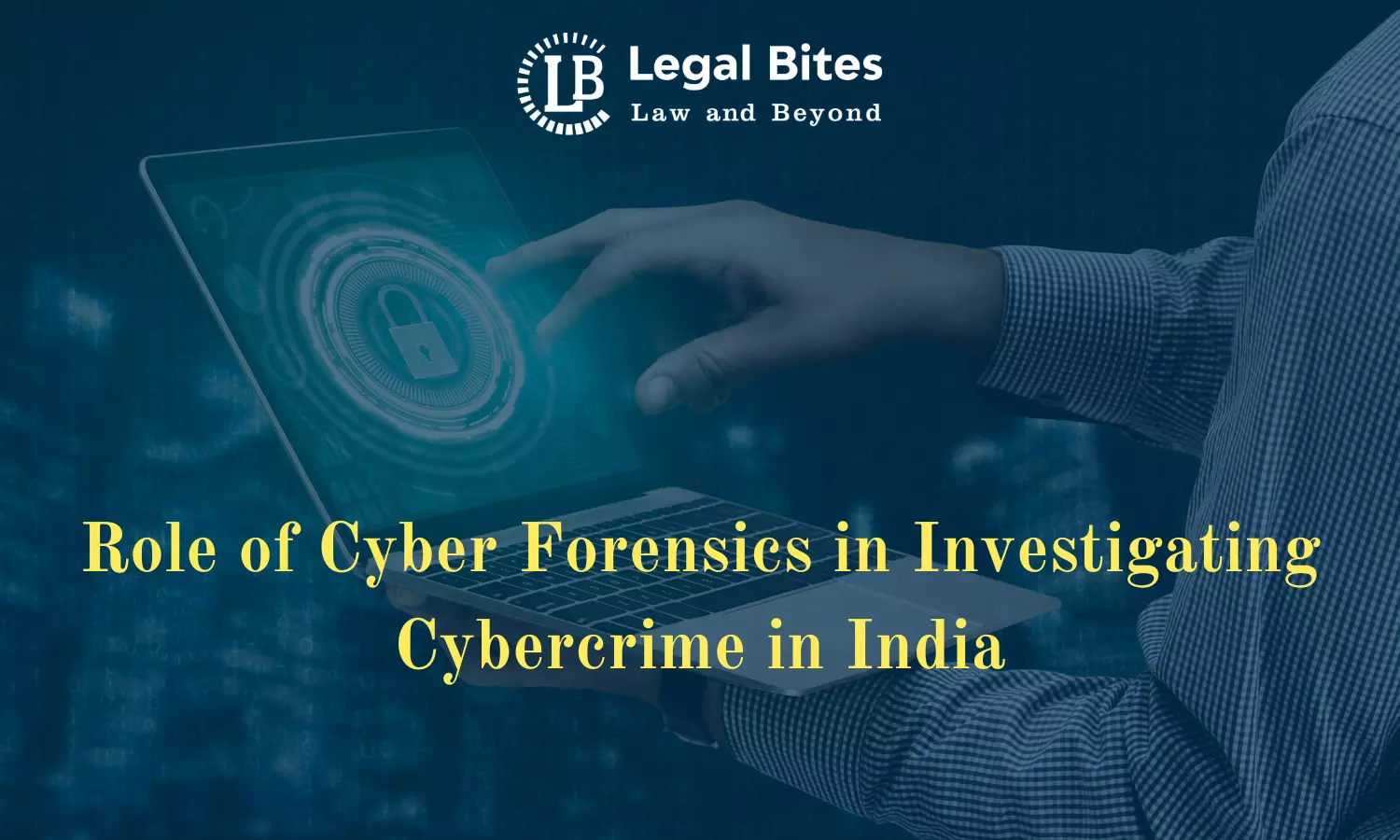Role of Cyber Forensics in Investigating Cybercrime in India
This article explores cyber forensics' role in investigating cybercrime in India, its methods, legal framework, challenges, and future scope.

As India embraces digital transformation, the incidence of cybercrime has risen sharply. The country's increasing reliance on technology and digital platforms has opened up new avenues for criminal activities. To counter these threats, cyber forensics has emerged as a vital tool in law enforcement's arsenal, enabling investigators to effectively track, preserve, and analyze digital evidence.
A Brief Introduction: Cybercrime in India
Cybercrime refers to illegal activities that are carried out using computers, digital devices, or networks. These crimes may target individuals, organizations, or the government and include offences like data theft, financial fraud, hacking, cyberstalking, identity theft, phishing, and ransomware attacks. With over 800 million internet users in India, cyber crimes have become increasingly sophisticated, posing significant risks to national security, individual privacy, and economic stability.
The Information Technology (IT) Act, 2000 (amended in 2008), serves as the primary legislation in India governing cybercrime. It defines various cybercrimes and prescribes penalties for offenders. However, due to the evolving nature of cyber threats, the role of cyber forensics in investigating these crimes has become indispensable.
What is Cyber Forensics?
Cyber forensics, also known as digital forensics, involves the identification, preservation, extraction, analysis, and presentation of digital evidence from electronic devices. Its primary objective is to establish facts in legal proceedings and provide answers related to digital offences. Cyber forensics covers a wide range of areas, including:
- Computer forensics – Investigation of crimes involving computers.
- Network forensics – Monitoring and analysis of computer network traffic to gather information and detect cyberattacks.
- Mobile device forensics – Extraction of data from mobile devices such as smartphones and tablets.
- Cloud forensics – Investigating crimes involving data stored on cloud computing platforms.
Cyber forensic experts work closely with law enforcement agencies to solve cases related to hacking, unauthorized access, digital fraud, and cyberterrorism.
The National Cyber Forensic Laboratory (NCFL) has been established in New Delhi to provide advanced forensic analysis and investigation of cybercrimes. Equipped with the latest digital technologies, it supports law enforcement agencies in their cybercrime investigations.
Role of Cyber Forensics in Investigating Cybercrime
Identification and Collection of Digital Evidence
One of the primary functions of cyber forensics is to identify and collect digital evidence from devices such as computers, smartphones, hard drives, and networks. In a cybercrime investigation, forensic experts use specialized tools to recover deleted, hidden, or encrypted data that could serve as critical evidence. For example, in a data breach case, logs of user activity, IP addresses, and communication records may be retrieved to track down the perpetrator.
The tools used in cyber forensics include EnCase, FTK (Forensic Toolkit), Autopsy, and Magnet AXIOM, which help experts perform disk imaging, recover lost data, and analyze digital footprints.
Preservation of Evidence
Digital evidence is volatile and can be easily tampered with or erased. Ensuring the integrity of such evidence is critical for its admissibility in court. Cyber forensic investigators preserve evidence by creating exact replicas (bit-by-bit copies) of the original storage devices. This process, known as disk imaging, ensures that the original data remains unaltered, maintaining the chain of custody and ensuring that the evidence can be presented in legal proceedings.
Analysis and Interpretation of Evidence
Once the data is collected and preserved, the next step is analyzing it to extract useful information. This could involve decrypting files, tracing IP addresses, recovering deleted emails, or analyzing metadata to determine the time and location of specific actions. For instance, in financial fraud cases, forensic experts may trace the transaction history to uncover fraudulent transfers or withdrawals.
In cases of hacking or unauthorized access, forensic analysis helps trace the attack back to its source by examining system logs, network traffic, and malicious software used during the attack. Network forensics tools like Wireshark and tcpdump are used to monitor and analyze packet data for detecting intrusions.
Presentation of Evidence in Court
Forensic experts play a vital role in translating technical findings into evidence that can be understood by judges, lawyers, and juries. This involves presenting complex digital data clearly and concisely during trials. Cyber forensic reports typically include the methods used for data collection, the evidence recovered, and the interpretation of this data concerning the crime. Expert witnesses may also be called upon to testify in court to explain the technical aspects of the investigation.
Prevention and Mitigation of Cybercrime
Beyond solving cases, cyber forensics also aids in preventing future cybercrimes. By understanding the methods used by cybercriminals, organizations and individuals can adopt better cybersecurity practices, such as enhancing firewalls, encryption techniques, and password management systems. Forensic experts often assist in post-incident analysis, helping companies understand how breaches occurred and what can be done to prevent similar incidents in the future.
Legal Framework for Cyber Forensics in India
The investigation of cybercrime in India is governed by multiple legal provisions, with the Information Technology (IT) Act, 2000 being the most prominent. Section 75 of the IT Act empowers Indian authorities to investigate cybercrimes committed outside India if the crime involves a computer system or network located in India.
In addition to the IT Act, Bharatiya Nyaya Sanhita, 2023, includes provisions that criminalize offences such as identity theft, cyberstalking, and financial fraud. Sections 62 and 63 of the Bharatiya Sakshya Adhiniyam, 2023 (BSA) set forth the rules regarding the admissibility of electronic records in legal proceedings.
However, the legal framework for handling digital evidence in India is still evolving. While cyber forensics experts are recognized under the law, there are challenges in ensuring that evidence is collected, preserved, and presented in a manner that adheres to legal standards. The need for specialized training in cyber forensics for law enforcement agencies is critical to ensure the effective prosecution of cybercriminals.
Challenges in Cyber Forensics Investigations
1. As cybercrime becomes more sophisticated, investigators require specialized training and access to advanced tools to tackle complex cases. However, many police departments and investigative agencies lack the necessary resources and expertise to carry out cyber forensics investigations effectively.
2. Cybercriminals often use encryption and anonymization techniques to conceal their identities and evade detection. While encryption protects privacy, it also poses a significant challenge to forensic experts trying to access critical evidence.
3. Cybercrimes often transcend geographical boundaries, making it difficult for law enforcement agencies to investigate and prosecute offenders.
Future of Cyber Forensics in India
As India continues to digitalize its economy and infrastructure, the importance of cyber forensics will only grow. The government has taken steps to strengthen its cybersecurity framework, such as establishing the Indian Computer Emergency Response Team (CERT-In) and implementing the National Cyber Security Policy. The rise of Artificial Intelligence (AI) and Machine Learning (ML) is expected to further aid forensic experts in analyzing vast amounts of data quickly and accurately.
However, the future success of cyber forensics in India depends on addressing the challenges of inadequate resources and expertise. Investing in training for law enforcement agencies, creating specialized cyber forensic labs, and fostering international collaboration will be essential in combating cybercrime effectively.
Conclusion
Cyber forensics has become an essential component in the fight against cybercrime in India. It enables law enforcement agencies to collect and analyze digital evidence, trace cybercriminal activities, and bring offenders to justice. However, the evolving nature of cyber threats necessitates continuous adaptation of forensic techniques, legal frameworks, and resource allocation. As cybercrimes continue to rise, the importance of developing a robust cyber forensic infrastructure in India cannot be overstated.
References
[1] Bharatiya Nyaya Sanhita, 2023
[2] Information Technology Act, 2000
[3] Bharatiya Sakshya Adhiniyam, 2023
[4] Key Government’s Initiatives to Enhance Cybersecurity Awareness, Available Here
[5] National Cyber Forensic Laboratory, Available Here

Apurva Neel
I am a Research Associate and Editor at Legal Bites with an LL.M. specialization in Corporate and Commercial Laws from Amity University, Mumbai. I have put my best efforts into presenting socio-legal aspects of society through various seminars, conferences etc. I keep refining content as I am an ardent writer, and palpably law has got multi-dimensional aspect, so I passionately try to explore ahead.
